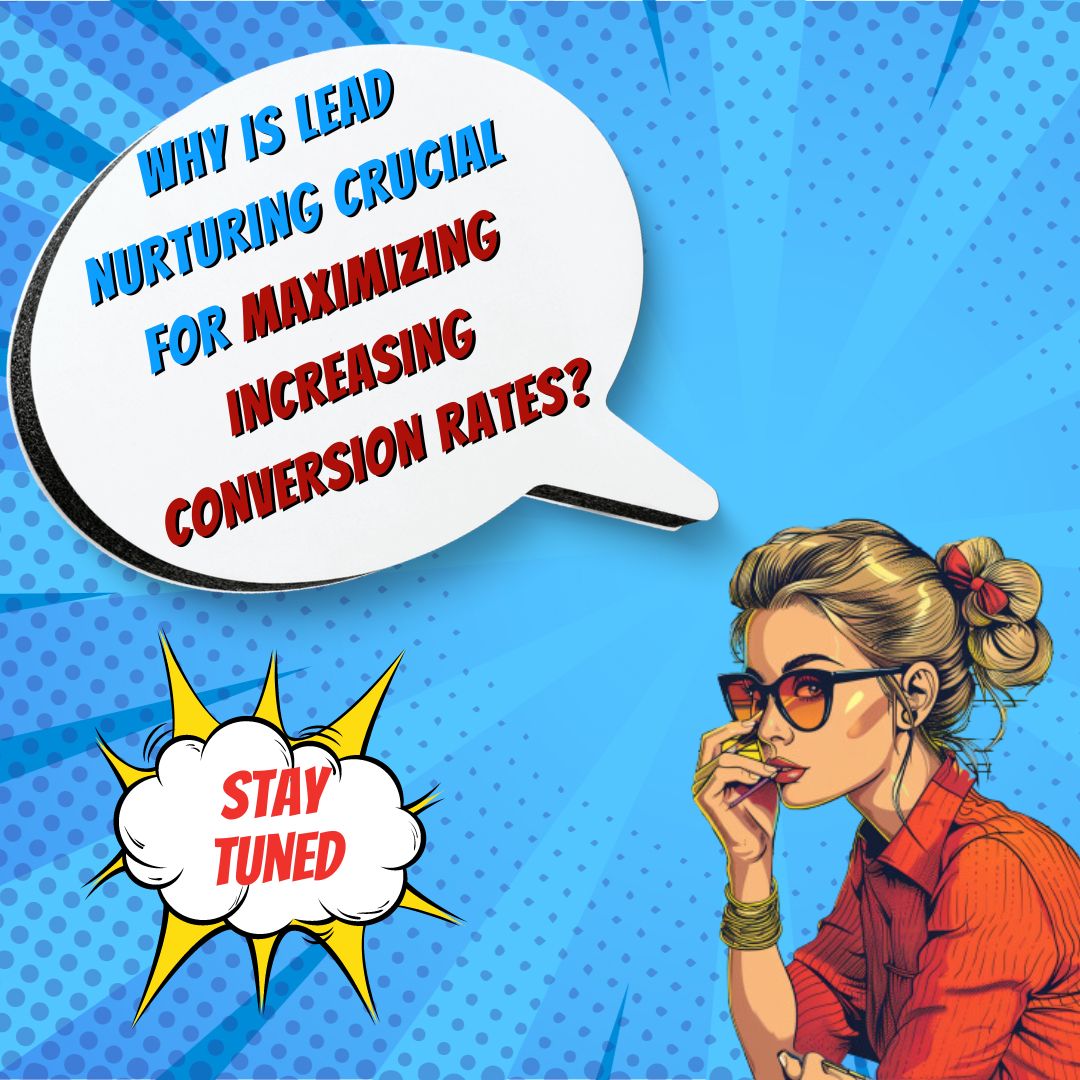Key Takeaways
✅ Personalization and Consistency are Key: Tailoring your messages to meet the unique needs and interests of your leads can significantly increase engagement rates. Statistics show that personalized emails have an open rate 26% higher than non-personalized ones. Regularly providing relevant and valuable content establishes your brand as a trustworthy source, encouraging leads to move further down the sales funnel.
✅ Multichannel Approach and Adaptation: Consumers today use a variety of platforms to gather information. A successful lead nurturing strategy involves reaching out to your audience where they are, be it on email, social media, or content platforms. Utilizing a mix of channels increases touchpoints, with studies indicating that a 3-4 channel approach can boost engagement by up to 300%. Adapting your message to suit the specific platform and the lead's stage in the funnel is crucial for maintaining relevance.
✅ Value Provision and Relationship Building: Delivering continuous value to your leads is essential for conversion. This could mean offering insightful articles, practical tools, or exclusive deals that speak directly to their needs. Building a strong relationship rooted in trust and mutual benefit can lead to a 5% increase in customer retention, which can boost profits from 25% to 95%.
Introduction
Have you ever wondered why some customers stay loyal to a brand for years, singing its praises, while others disappear after a single transaction? The secret often lies in the art of lead nurturing: a critical but frequently overlooked strategy that can turn indifferent leads into enthusiastic brand advocates.
In today's fast-paced digital world, grabbing the attention of potential customers is just the first step; the real challenge is keeping them engaged and guiding them through the sales funnel until they're not just ready to buy, but excited to do so. Effective lead nurturing leverages personalized communication, a strategic multichannel presence, and the consistent provision of value to build lasting relationships that culminate in loyalty, and yes, increased revenue.
As we dive deeper, we'll explore the nuances of creating compelling lead nurturing emails, setting up multifaceted campaigns, and measuring their success in tangible terms. We'll look at modern trends that shape consumer expectations and the innovative solutions that businesses are employing to meet them head-on, maximizing not just revenue, but Return On Ad Spend (ROAS) and Return On Investment (ROI) alike.
Prepare to uncover actionable insights and groundbreaking information that will not only enhance your understanding of lead nurturing but also equip you with the tools to implement a strategy that converts leads into not just customers, but fans.
Top Statistics
| Statistic | Insight |
|---|---|
| 50% more sales-ready leads at 33% lower cost | Shows the efficiency and cost-effectiveness of lead nurturing, highlighting that companies investing in it are not just increasing their volume of leads but are doing so more affordably. |
| 20% increase in sales opportunities | Lead nurturing isn't just about immediate sales; it's about opening a wider door to potential future sales, underscoring the long-term value of nurturing relationships with leads. |
| 80% of marketing leads don’t convert | A stark reminder of the challenge at hand, this statistic highlights the crucial need for consistent and effective lead nurturing to bridge the gap between lead generation and actual sales conversions. |
| 4400% ROI | Email marketing, often used for lead nurturing, comes through as a heavyweight champion in terms of ROI, emphasizing its unrivalled effectiveness and efficiency as a lead nurturing tactic. |
What is Lead Nurturing?
Lead nurturing is the process of developing relationships with buyers at every stage of the sales funnel and through every step of the buyer's journey. It focuses on listening to the needs of prospects and providing the information and answers they need. The importance of lead nurturing cannot be overstressed; it is a critical component of a successful sales strategy. Effective lead nurturing helps businesses to stay connected with their potential customers, gently guiding them until they are ready to make a purchase. The benefits are clear: businesses that excel in lead nurturing generate more sales at a lower cost, enjoy higher customer retention rates, and often see an increase in the value of each customer.
Elements of a Successful Lead Nuring Email
A lead nurturing email must have several key components to be successful: a compelling subject line, relevant content, personalization, visual appeal, and it must be mobile-friendly. The subject line is your first (and sometimes only) shot at getting the recipient's attention, so it must spark interest or curiosity. Content relevance ensures the email addresses the recipient's needs or interests, making them more likely to engage. Personalization can significantly increase the effectiveness of your emails, making the recipient feel known and valued. Visual appeal makes your emails pleasing to the eye, while mobile compatibility ensures everyone can easily read your message, no matter what device they use.
Creating a Lead Nurturing Process
Creating a data-backed lead nurturing plan requires alignment across marketing, sales, and customer support teams. This harmonization ensures a seamless experience for the customer, where their needs are recognized and met at all stages. Employing a multi-channel approach, combining email, social media, and content marketing, with a mix of automation for efficiency and personal touch for authenticity, is key. Timely outreach can mean the difference between a lost lead and a new customer. Integrating automation tools can help to scale your efforts, but always remember that personal interaction adds an invaluable layer of connection.

Best Practices for B2B Lead Nurturing
For B2B businesses, targeted content that addresses where the contact is in the sales funnel is vital for moving them towards a purchase. Understanding the funnel stages and utilizing lead scoring or grading models to prioritize your efforts can significantly increase efficiency and effectiveness. Providing content tailored to different lead statuses ensures that potential customers receive the most relevant and engaging information. Several successful B2B lead nurturing strategies include consistent and personalized outreach, educational content, and leveraging customer testimonials or case studies.
Setting Up a Lead Nurturing Campaign
To set up an effective lead nurturing campaign, start by defining your goals and understanding your audience. Utilize an infographic to outline key steps and considerations, making the process visually easy to understand. Ensure that your content speaks directly to the needs and interests of your prospects, guiding them through the funnel with timely and pertinent information. Regularly test and refine your emails for optimum performance. Good lead nurturing campaigns are dynamic, adapting to the continuous changes in customer behavior and preferences.
Measuring the Success of Lead Nurturing
Tracking the right metrics is essential for measuring the success of your lead nurturing efforts. Key indicators include email open rates, click-through rates, conversion rates, and ultimately, sales revenue. Constant analysis of these metrics allows for the refinement and optimization of your strategy. Evaluating the impact on ROI and sales conversions provides the clearest picture of the effectiveness of your lead nurturing campaign. Remember, improvement is an ongoing process that requires attention to detail and a willingness to adapt strategies as needed.

AI Marketing Engineers Recommendation
Recommendation 1: Personalize Your Communication: Ensure your leads turn into customers by personalizing your communication. A recent study shows that emails with personalized subject lines are 26% more likely to be opened. But don't stop there. Use data analytics to understand your lead's behavior, preferences, and needs. Tailor your content, offers, and outreach timing to each lead, making them feel valued and understood. Personalization isn't just a trend; it’s a proven strategy to enhance engagement and conversions.
Recommendation 2: Leverage Marketing Automation for Consistent Follow-ups: Consistency is key in lead nurturing. However, manually following up with each lead can be time-consuming and prone to error. This is where ensuring your leads turn into customers can benefit significantly from marketing automation tools. Automation allows you to schedule regular, targeted communications based on specific triggers or lead actions, making sure no lead falls through the cracks. Companies using marketing automation for nurturing leads see a 451% increase in qualified leads, according to the Annuitas Group. Remember, effective lead nurturing is about timely and relevant communication, and automation tools can help achieve that at scale.
Recommendation 3: Integrate Social Proof into Your Nurturing Campaigns: Trust plays a significant role in converting leads into customers. Integrate social proof like testimonials, reviews, and case studies into your nurturing efforts to build credibility. In a world where 91% of people read online reviews before making a purchase, showcasing positive feedback from satisfied customers can significantly influence potential buyers. Incorporate these elements into emails, on your website, and across social media channels to ensure your leads turn into customers. Social proof not only increases trust but also enhances the perceived value of your offerings, making leads more likely to commit to a purchase.

Conclusion
To wrap up, Lead Nurturing stands out not just as a buzzword but as a fundamental pillar in transforming contacts into dedicated customers. Reflecting on the strategies and insights shared, it's evident that nurturing leads is much more than sending out emails; it's about creating a relationship. The essence of effective lead nurturing pivots on understanding the needs and journey of your potential customers. It's about delivering personalized, relevant content at just the right moment to guide them further down the sales funnel.
From the meticulous crafting of lead nurturing emails that resonate with the recipient, to the strategic orchestration of the nurturing process across multiple channels, each step is pivotal. Aligning sales, marketing, and customer support teams underlines the importance of a united front when engaging with prospects. Moreover, leveraging automation alongside a personal touch can significantly elevate the impact of your lead nurturing efforts.
Implementing best practices for B2B lead nurturing, such as targeted content tailored to different stages of the sales funnel, not only fosters trust but also enhances your relationship with each lead. The emphasis on continuous optimization, backed by tracking the right metrics, cannot be understated.
We're living in an era where converting a lead into a customer requires more than just touchpoints; it demands trustpoints. The journey doesn’t end at the first purchase; it’s just beginning. Looking forward, businesses that adopt a dynamic, responsive lead nurturing strategy will not only see a notable uplift in conversions but also build stronger, lasting relationships with their customers.
Let this be a call to action for all marketing professionals: to not just chase leads, but to nurture them. After all, in the whirlwind of acquisition and conversion, it's the thoughtfully nurtured relationships that yield the most substantial, lasting value for your business. What steps will you take to ensure your lead nurturing process not only exists but thrives?

FAQs
Question 1: What is lead nurturing?
Answer: Lead nurturing is like tending to a garden, making sure that prospects who aren't quite ready to buy just yet are given the care (in this case, relevant content and a bit of relationship-building) they need to eventually bloom into customers.
Question 2: Why is lead nurturing important?
Answer: It's crucial because it's like laying down a path of breadcrumbs. You're gradually building brand loyalty, nudging those unsure prospects along the way, and guiding them towards making a purchase, which, in turn, boosts your revenue.
Question 3: What are the key stages of the buyer’s journey?
Answer: Picture the buyer’s journey as a winding road with four main stops: awareness, consideration, buying, and retention. At each stage, the traveler (your lead) needs different things to keep them moving forward towards their purchase destination.
Question 4: How do you define a lead?
Answer: A lead is someone who might buy from you, but to make sure everyone agrees on who fits that bill, sales and marketing teams get together to create what's called a Universal Lead Definition (ULD). This is a kind of checklist to decide if someone is indeed a lead worth pursuing.
Question 5: What is the difference between an inquiry and a qualified lead?
Answer: Think of an inquiry as someone casually peeking into a store and a qualified lead as someone who walks in knowing what they want to buy. The latter matches the checklist (the ULD) and is more likely to make a purchase.
Question 6: How do you convert an inquiry into a lead?
Answer: It’s like having a map where X marks the treasure. You need to draw a path for these inquiries, leading them through different challenges (micro-conversions) that nudge their interest and intent higher and higher until they become genuine leads.
Question 7: What metrics should you use to measure the performance of lead nurturing?
Answer: Keeping track of your lead nurturing's success is like checking your vehicle’s dashboard. You want to pay attention to things like how many drop off (unsubscription rate), how many are engaging (open rate, click-through rate), how fast you're moving them through to a sale (length of the sales cycle), and how much value each customer is bringing in (revenue per customer).
Question 8: When should you start building a lead nurturing campaign?
Answer: Yesterday! Building a solid lead nurturing campaign is not an overnight task. The sooner you start, the sooner you'll see those little seeds you’ve planted start to sprout into paying customers.
Question 9: Who is responsible for lead nurturing campaigns?
Answer: Lead nurturing is a team sport where both the marketing and sales departments need to work together, passing the baton back and forth to ensure the prospect keeps moving smoothly towards a purchase.
Question 10: How do you personalize content for lead nurturing?
Answer: By acting a bit like a detective—use analytics to figure out what your potential customers are really looking for, and then bring in the proof (customer success stories) that what you're offering is indeed the answer to their needs.
Question 11: Can you use blog posts in lead nurturing?
Answer: Absolutely, as long as they’re not as dry as a textbook. Make sure the content is digestible for where your customer is at in their journey, and keep any data or stats fresh and accurate.
Question 12: What is omnichannel lead nurturing?
Answer: It's like being everywhere your customer looks without overwhelming them. You're educating and engaging them through emails, social media, webinars—you name it, making sure the message is consistent and efficient no matter the channel.
Question 13: When does lead nurturing end?
Answer: Spoiler: It doesn’t really end. Whether it’s getting a new customer onboard, keeping existing ones happy, or continuing to educate on relevant topics, the nurturing goes on.
Question 14: How do you handle stale leads?
Answer: If someone hasn’t engaged in a while, it might be time for a refresh. Reach out again, but keep in mind they might no longer be interested, or their situation could have changed.

Academic References
- Ortto; UPILA. Segmentation and Personalization in Lead Nurturing Practices. This reference highlights the importance of dividing leads into distinct groups based on various characteristics and tailoring content specifically to cater to each segment's needs and preferences, thereby enhancing the potential for conversion.
- UPILA. Data Enrichment and Progressive Profiling Techniques. This source sheds light on the process of gradually gathering more information about potential customers through interactions such as surveys and discovery calls, which in turn enables the creation of more targeted and effective nurturing campaigns.
- Zendesk; UPILA. (2021). Understanding the Importance of Lead Nurturing. According to this source, a striking 80% of new leads do not result in sales, underlining the critical role of lead nurturing in boosting conversion rates and the value of sales orders, thereby emphasizing its strategic significance in marketing.
- HubSpot Community. Metrics for Measuring Success in Lead Nurturing. This reference discusses the analytical aspect of lead nurturing, focusing on the importance of tracking specific metrics to ascertain the effectiveness of various strategies in guiding potential customers through the sales funnel.
- Ortto; UPILA; Finalsite. Content Creation and Automation in Lead Nurturing. Here, the emphasis is on the dual strategy of developing trustworthy, targeted content and deploying automated processes to nurture leads effectively across different stages of the customer journey, ultimately leading to higher conversion rates.


